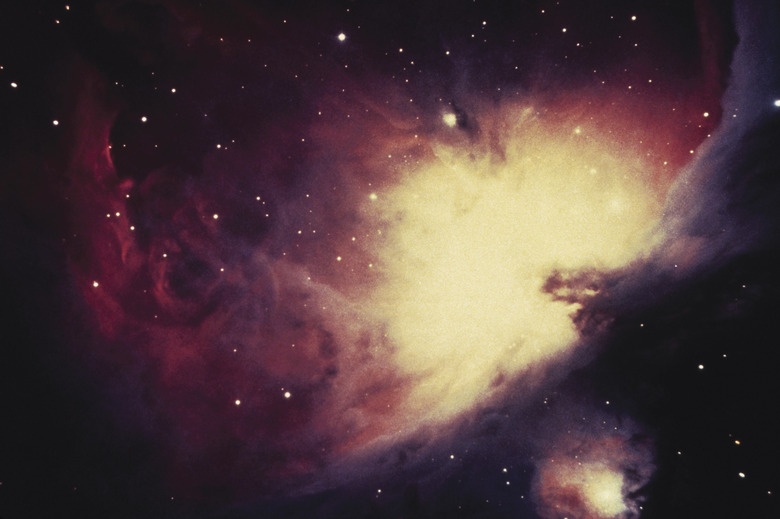How Can A Nebula Eventually Become A Black Hole?
Gravity is a powerful force: it keeps the planets revolving in their orbits around the sun, and it was even responsible for forming the planets, as well as the sun, from nebulae. Not only that, it's the force that ultimately destroys stars like the sun when they run out of hydrogen to burn. If a star is large enough — which is determined when it forms — gravity can turn it into a black hole.
Clumps of Dust
Clumps of Dust
Nebulae are clouds of dust and gas that pervade the universe. Matter within a given nebula is distributed unevenly, and the temperature is low — just above absolute zero. At these temperatures, gas molecules bind together to form clumps, and a clump growing in a dense region of a nebula — called a molecular cloud — can begin to attract matter toward itself. As the clump grows, the temperature at its core increases because gravitational attraction increases the density and kinetic energy of the particles, which collide with each other more and more frequently and with more and more energy.
Main Sequence Stars
Main Sequence Stars
It takes about 10 million years for a star to form from a clump of intergalactic dust. As the temperature of the core increases, it becomes a protostar and radiates infrared light, but as the core becomes denser and opaque, this energy is trapped, which accelerates heating. When the core temperature reaches 10 million Kelvins (18 million degrees Fahrenheit), hydrogen fusion begins, and the outward pressure of that reaction balances the compressive force of gravitation. The star enters its main sequence, which can last from 100 million to over a trillion years, depending on the star's mass. During its main sequence, the star maintains a fixed radius and temperature.
Blue Giant Stars
Blue Giant Stars
Very large stars, which are those with masses 25 times or more that of the sun, can become black holes. Because of the tremendous pressure generated at the core of a massive star, it burns hotter and faster than a smaller star. Such stars, when they are in their main sequence, burn with a bluish light and can have surface temperatures of 20,000 Kelvin (35,450 degrees Fahrenheit). By comparison, the sun's surface temperature is only about 6,000 Kelvin (10,340 degrees Fahrenheit). Because it burns so hot, a massive star can run out of hydrogen in a fraction of the time it takes for a sun-size star to burn out.
Formation of a Black Hole
Formation of a Black Hole
When a blue giant runs out of hydrogen, its core begins collapsing, which generates enough pressure to initiate helium fusion. Other fusion reactions occur as the core continues to collapse, and at a certain point, the star runs out of fusible material. At a critical point, the core implodes in what is called a supernova, which blows the star's outer shell into space. If the matter left over after the supernova has a mass of three times or more that of the sun, nothing can stop gravity from collapsing into a point with infinite mass. This point is a black hole.
Cite This Article
MLA
Deziel, Chris. "How Can A Nebula Eventually Become A Black Hole?" sciencing.com, https://www.sciencing.com/can-nebula-eventually-become-black-hole-20883/. 24 April 2017.
APA
Deziel, Chris. (2017, April 24). How Can A Nebula Eventually Become A Black Hole?. sciencing.com. Retrieved from https://www.sciencing.com/can-nebula-eventually-become-black-hole-20883/
Chicago
Deziel, Chris. How Can A Nebula Eventually Become A Black Hole? last modified March 24, 2022. https://www.sciencing.com/can-nebula-eventually-become-black-hole-20883/
